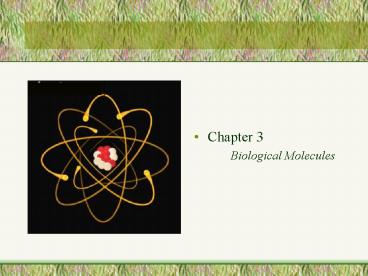Biological Molecules - PowerPoint PPT Presentation
1 / 22
Title:
Biological Molecules
Description:
Isomers (same molecular formula, but different structure & properties) ... bonds between monomers are broken by adding water (digestion) ... – PowerPoint PPT presentation
Number of Views:511
Avg rating:3.0/5.0
Title: Biological Molecules
1
- Chapter 3
- Biological Molecules
2
Organic chemistry
- Derived from the ability of organisms to
synthesis and use organic molecules molecules
that have a carbon skeleton and contain some
hydrogen atoms - Carbon is tetravalence tetrahedron shape
determines function
3
Hydrocarbons
- Only carbon hydrogen
- Covalent bonding nonpolar
- High energy storage
- Isomers (same molecular formula, but different
structure properties) - structuraldiffering covalent bonding
arrangement - geometricdiffering spatial arrangement
- enantiomersmirror images pharmacological
industry (thalidomide)
4
Functional Groups, I
- Attachments that replace one or more of the
hydrogens bonded to the carbon skeleton of the
hydrocarbon - Each has a unique property from one organic to
another
- Hydroxyl Group H bonded to O
alcohols polar (oxygen) solubility in
water - Carbonyl Group C double bond to O At
end of H-C- aldehyde Otherwise ketone
5
Functional Groups, II
- Sulfhydral Group sulfur bonded to H
thiols - Phosphate Group phosphate ion covalently
attached by 1 of its O to the C skeleton
- Carboxyl Group O double
bonded to C to hydroxyl carboxylic
acids covalent bond between
O and H polar
dissociation, H ion - Amino Group N to 2 H atoms amines
acts as a base (1)
6
Polymers
- Covalent monomers
- Condensation reaction (dehydration reaction)
- One monomer provides a hydroxyl group while
the other provides a hydrogen to form a water
molecule - Hydrolysis
- bonds between monomers are broken by adding
water (digestion)
7
Dehydration Synthesis and Hydrolysis in Action
Animation
8
Carbohydrates, I
- Monosaccharides v CH2O formula
v multiple hydroxyl (-OH) groups and 1 carbonyl
(CO) group aldehyde (aldoses) sugar
ketone sugar v cellular
respiration v raw material for amino
acids and fatty acids
9
Carbohydrates, II
- Disaccharides v glycosidic linkage
(covalent bond) between 2 monosaccharides
v covalent bond by dehydration reaction - Sucrose (table sugar) v most common disaccharide
10
Carbohydrates, III
- Polysaccharides Storage Starch glucose
monomers Plants plastids Animals
glycogen
- Polysaccharides Structural
Cellulose most abundant organic
compound Chitin exoskeletons cell walls
of fungi surgical thread
11
Lipids
- No polymers glycerol and fatty acid
- Fats, phospholipids, steroids
- Hydrophobic H bonds in water exclude fats
- Carboxyl group fatty acid
- Non-polar C-H bonds in fatty acid tails
- Ester linkage 3 fatty acids to 1 glycerol
(dehydration formation) - Triacyglycerol (triglyceride)
- Saturated vs. unsaturated fats single vs. double
bonds
12
Lipids, II
13
Phospholipids
- 2 fatty acids instead of 3 (phosphate group)
- Tails hydrophobic heads hydrophilic
- Bilayer (double layer) cell membranes
14
Steroids
- Lipids with 4 fused carbon rings
- Ex cholesterol cell membranes precursor for
other steroids (sex hormones)
atherosclerosis
15
Proteins
- Importance instrumental in nearly
everything organisms do 50 dry weight of cells
most structurally sophisticated molecules known - Monomer amino acids (there are 20)
carboxyl (-COOH) group, amino group (NH2), H
atom, variable group (R). - Variable group characteristics
polar (hydrophilic), nonpolar (hydrophobic),
acid or base - Three-dimensional shape (conformation)
- Polypeptides (dehydration reaction)
peptide bonds covalent bond carboxyl group to
amino group (polar)
16
Primary Structure
- Conformation Linear structure
- Molecular Biology each type of protein has
a unique primary structure of amino acids - Ex lysozyme
- Amino acid substitution hemoglobin sickle-cell
anemia
17
Secondary Structure
- Conformation coils folds
(hydrogen bonds) - Alpha Helix coiling keratin
- Pleated Sheet parallel silk
18
Tertiary Structure
- Conformation irregular contortions from R
group bonding vhydrophobic vdisulfide
bridges vhydrogen bonds vionic bonds
19
Quaternary Structure
- Conformation 2 or more polypeptide
chains aggregated into 1 macromolecule vcollagen
(connective tissue) vhemoglobin
20
Nucleic Acids, I
- Deoxyribonucleic acid (DNA)
- Ribonucleic acid (RNA)
- DNA-gtRNA-gtprotein
- Polymers of nucleotides (polynucleotide) nitrog
enous base pentose sugar phosphate group - Nitrogenous bases pyrimidinescytosine,
thymine, uracil purinesadenine, guanine
21
Nucleic Acids, II
- Pentoses vribose (RNA) vdeoxyribose
(DNA) vnucleoside (base sugar) - Polynucleotide vphosphodiester linkages
(covalent) phosphate sugar
22
Nucleic Acids, III
- Inheritance based on DNA replication
- Double helix (Watson Crick - 1953) H
bonds between paired bases van der Waals
between stacked bases - A to T C to G pairing
- Complementary
- More to come on this subject later






























